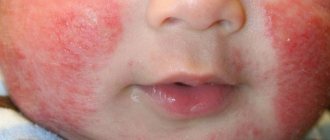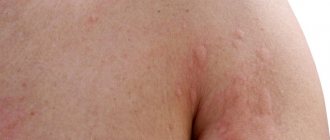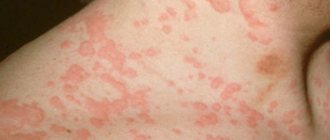Rubella is a viral disease transmitted by airborne droplets. Most often, infection occurs in the off-season - in spring and autumn, when immunity decreases. The disease is transmitted from a carrier of the virus, that is, from an infected adult or child, during the incubation period. The disease is dangerous for pregnant women, as well as people who have not had an infectious disease in childhood. At the same time, the course of rubella in adults is more severe than in younger children. Therefore, rubella in adults must be treated under medical supervision.
Signs of illness
In order to detect the development of rubella in time, you should know the first signs of the disease, try to isolate the infected family member and seek qualified medical help.
Quite often, the onset of rubella is mistaken for the development of acute respiratory infections, since the primary manifestations are similar - headache, sore throat, chills. But only after a few days do special signs begin to appear, indicating the development of an infectious lesion of the body in an adult:
- the appearance of a spotted, measles-like rash on the face and hands;
- the rash spreads chaotically throughout the body in just a few hours;
- body temperature rises.
Only after the appearance of these symptoms can one suspect the development of rubella or measles, since the rash at first is similar. Then, over the next 3 days, other symptoms appear:
- conjunctivitis – develops on days 3-4;
- tearing in bright light;
- muscle and joint pain (ache);
- rhinitis;
- Men may experience pain in the groin, which goes away as they recover.
To confirm the diagnosis, clinical blood tests may be ordered, which show an increase in lymphocytes, monocytes and plasma cells, as well as an increase in white blood cells.
Main routes of transmission of the virus
Clinical manifestations and severity of the disease vary with age. For example, infection in young children is characterized by mild constitutional symptoms, rash and suboccipital adenopathy, while in older children, adolescents and adults, rubella can cause complications.
There are three main ways to become infected with rubella:
- airborne droplets (during a conversation or after a kiss);
- transplacental or vertical (intrauterine infection of the fetus from a woman who became ill while carrying a child);
- household or contact (if shared dishes, hygiene items, toys were used).
Most rubella infections today occur in young, unimmunized adults rather than children. In fact, experts estimate that 10% of young people are currently exposed to rubella, and when active, the disease can pose a risk to children they come into contact with or to subsequent offspring.
Read: A blood test for rubella is a reliable way to diagnose the disease
What is the causative agent
The causative agent of rubella is a virus belonging to the Togavirus family, Rubivirus genus. This pathogen has low characteristics for life outside the body, and dies within a couple of hours in the environment. It is small in size and has RNA.
Rubinovirus is very sensitive to elevated temperatures, does not tolerate ultraviolet rays, disinfectants, acidic and alkaline environments, but is resistant to low temperatures and retains its functions when frozen. It has cytopathic characteristics, reproduces well in host cells during infection, and also affects neighboring ones, provoking degeneration and the formation of cells with several nuclei.
During the development of the rubella virus, the body produces two types of antibodies - IgG and IgM, which indicate whether the disease is acute or latent.
In this case, it is not necessary to treat rubella; it is only necessary to suppress the symptoms.
What rubella looks like
In order to understand what rubella looks like in adults, you can look at photos of patients during the period of active rash. The rash usually appears first on the head and then gradually spreads throughout the body. The photo shows that these are small rashes with colors ranging from light pink to red.
In adults, the rashes appear more actively than in children, and may cause some itching. At the same time, not a single photograph will convey the general condition of the patient, manifested in the form of general malaise, fever, and weakness.
rubella in adults in the photo
To accurately determine the diagnosis, it is necessary to contact a specialist when the first symptoms appear, who can accurately diagnose and prescribe the correct treatment. After all, as you know, rubella is a “childhood infection” and adults suffer from it much more difficult with complications.
Course of the disease in pregnant women
The virus is most dangerous for pregnant women, as it can be transmitted to the fetus through the placenta. As a result of this, damage to any organ of the child is possible, but most often it provokes the development of cataracts, heart disease and deafness.
Also, the congenital rubella virus can lead to the following complications in a baby:
- a significant reduction in the skull, which ultimately prevents the full development of the brain;
- mental retardation;
- diabetes;
- pathological increase in the size of the liver and spleen;
- partial necrosis of cardiac muscle tissue;
- encephalitis;
- impaired development of bone tissue;
- pneumonia;
- delay in the development of all organs and systems.
The pathological impact of the virus can also manifest itself in the form of miscarriages (30%), stillbirths (20%) and death of the baby during childbirth (20%).
Depending on the age of the infected woman, fetal damage occurs in the following ratio:
- 1 week of pregnancy - 80%;
- 2-4 weeks - 60-65%;
- 5-8 weeks - 30-35%;
- 9-12 weeks - 10-12%.
As the fetus grows, the risk of infection decreases significantly, but even at 5 months there is a chance of infection for 1 child in 10 cases. Rubella in a pregnant woman is often the main indication for abortion.
Rubella symptoms
After infection, the symptoms of rubella do not begin to appear immediately, but only after 3-5 days. In adults, the disease is accompanied by the following symptoms:
- Red rashes are the main symptom indicating rubella. The rash in adults is significantly different from the rashes in children, as it forms continuous spots. At first, the rash forms small areas of damage, and over a short period it spreads throughout the body. The rash goes away 5-7 days after it appears. No special treatment is required.
- Feverish state - before the appearance of rashes, the patient’s body temperature rises, sometimes up to 40 C, while reducing it is quite problematic.
- Inflammation of the lymph nodes - the lymphatic system is affected on the 2nd day of infection, while the lymph nodes enlarge in different areas - the armpit, groin, neck, simultaneously or in turn.
- Headache - begins with minor discomfort and progresses to severe migraine attacks that cannot be treated with medication.
- Loss of appetite – an adult with rubella loses his appetite and experiences bouts of nausea. Such symptoms appear due to intoxication of the body due to an increase in body temperature and the release of toxic waste products of the virus in the body.
- Pain in muscles and joints can appear regardless of body temperature; such pain is very similar to the aching sensations associated with colds and flu.
- Symptoms of a cold - a viral disease causes persistent sensations similar to the symptoms of a cold. This may include a runny nose, pain and sore throat, and a dry cough. In some cases, such symptoms may appear in the first days of the incubation period, preceding the appearance of the rash, which confuses the patient with an accurate diagnosis. Moreover, if you use conventional drugs to treat a respiratory disease, the unpleasant symptoms do not go away, since the virus is not sensitive to antiviral drugs.
- Photophobia - in most cases of rubella infection in adults, discomfort in bright light may occur, accompanied by the release of tears.
- Conjunctivitis – sometimes, conjunctivitis may appear together with photophobia, and appears 2-3 days after infection. It mainly appears at night, and in the morning you can find your eyes stuck together from secretions.
If you suspect the development of rubella, it is not recommended to treat the disease yourself. To do this, at the first symptoms of the development of the disease, you need to contact a specialist and establish an accurate diagnosis.
What does it mean if Igg antibodies were detected?
Rubella is caused by the Rubella virus, which primarily affects young children and sometimes adults. To diagnose the disease in adults, enzyme-linked immunosorbent assay (ELISA) is mainly used, which allows to detect the presence of IgG and IgM antibodies to the virus in the blood. If, as a result of the study, Rubell IgG antibodies are detected in the blood, this indicates the presence of immunity to the virus, namely, that the patient has already suffered from the disease or has been successfully vaccinated, as a result of which his body has developed stable immunity. If the result shows IgM, this means that the patient is infected with active rubella.
In most cases, patients with rubella do not require special treatment, and IgG antibodies are produced by the body within 3-4 weeks after infection. At the same time, immunity is lifelong, which means that, having had the disease once, it is impossible to become infected again.
What does Igg positive mean?
photo of rubella in laboratory conditions
During the enzyme immunoassay, the presence of antibodies to the Rubella virus in the body of the IgG type is detected. If the answer is that the rubella virus with IgG antibodies is positive, then this result means the presence of immunity in the blood. Positive indicators in the IgG analysis occur when there is a history of rubella, or it means that vaccination was successful. There is no need to worry about a positive IgG antibody virus.
Measles, rubella, mumps vaccination
Viruses are epidemiological in nature. They cause considerable harm to the body:
- Disorders of the central nervous system.
- Optic nerve damage.
- Damage to the auditory nerve.
- Weakening of the body, leading to decreased immunity.
Measles, rubella, and mumps are dangerous for both women, especially during pregnancy, and men. In the first case, there is a risk for the child, even death. Statistics show that in 25% of cases when a pregnant woman is infected with rubella, measles or mumps, fetal death is inevitable.
In men, complications from the disease can lead to infertility. If a boy suffered from the disease in childhood, complications may be avoided. But if the disease occurred for a period of 13-15 years, then it may not respond to treatment and will become permanent.
But now it is possible to avoid infection. The vaccine against measles, rubella, mumps has not only been developed, but also combined into one shot. That is, one dose of vaccination will get rid of three dangerous viruses.
But it is worth considering that vaccination is possible only if measures and contraindications are observed. It is applicable for both prevention and emergency treatment.
Adults are given a course of two doses. The time between doses should be at least one month. One dose is not enough to create immunity, so a second final injection is required.
The full course will allow you to develop lasting protection and antibodies, allowing you to create immunity in the body to viruses. On average, a vaccine protects a person for ten years. Repeated revaccination is carried out once every ten years.
The child receives the injection in two approaches: in the first 12 months of life and at six years. Why is this period ideal? In the first year of life, vaccination will help prevent infection with the virus. And at six years old, the child goes to school, where he actively communicates with other children.
The second dose will create lasting immunity. Repeated revaccination is carried out after 10 years.
Treatment
In terms of its symptoms, rubella is similar to colds, which complicates diagnosis and timely treatment. Therefore, at the first alarming symptoms, it is necessary to consult a doctor and conduct an examination to detect antibodies to the Rubella virus.
The process of treating rubella in adults is to relieve symptoms.
There are no special drugs for the Rubella virus, and conventional antiviral and antibacterial drugs are not dangerous to the pathogenic microorganism. As a result of contracting the disease, a person develops stable, lifelong immunity to the pathogen. For mild to moderate cases of the disease, the disease can be treated at home, but if the disease causes complications in adults, then hospitalization in a hospital will be required. The patient should adhere to bed rest; if photophobia occurs, it is recommended to shade the room.
Immunostimulating drugs can be used as medications; if the rash is itchy, then use Dimentiden ointment, which relieves discomfort; high fever must be treated using antipyretics.
Complications and their consequences
This disease is characterized by a large number of subsequent and accompanying complications, many of which are so serious that they can be fatal.
Video - Rubella. How to avoid the consequences of the disease
Complications after rubella
| Pathology | Description | Consequences |
| Meningitis | This is a highly severe disease of viral etiology, which can occur as a complication after rubella | May cause nerve paralysis, contraction of respiratory muscles, seizures, coma and death |
| Pneumonia | Inflammation of an acute nature, covering all pulmonary structures. Occurs in those who have had rubella, against the background of any other infection attached to it | Patients still continue to die from pneumonia, despite the fact that there are many drugs that can combat the disease, mainly because the disease was not detected in time and treatment was not started in a timely manner. |
| Otitis | Ear otitis, manifested against the background of rubella by pain or discharge from the ears | It poses a great danger to patients with rubella. May cause partial or complete hearing loss if left untreated |
| Arthritis | Rubella is one of the reasons for the occurrence of a disease such as arthritis at a young age in patients. In this case, inflammation of the joints causes pain in them and deprives the patient of full movement. | Arthritis can lead to serious consequences and even bind a person to a wheelchair, practically immobilizing him |
| Pathologies of fetal development | These complications will arise not in an adult, but in a child in the womb who has had rubella. But therefore, it is all the more dangerous to allow the mother to become infected with this disease. | When the fetus is infected in the womb, pathologies of the nervous system, as well as hearing and vision in the newborn baby, are formed. It is so serious that mothers who develop rubella in the early stages are advised to terminate their pregnancy. |
How is rubella transmitted in adults?
Rubella is caused by a virus, which means the route of transmission of such an infection is airborne and contact. The disease can be transmitted from infected children and adults to people of any age who are not immune to the disease through close contact, for example, a conversation, a handshake, or being in a cramped room - an elevator or public transport.
A person carrying the virus is dangerous to others during the incubation period, which lasts 15-24 days. An adult or child with rubella does not always develop rashes, because the disease can be secretive and asymptomatic. Therefore, doctors recommend that all people who have not had the disease in childhood be vaccinated against rubella, because it is easier to tolerate vaccination than the disease itself with possible complications.
Reasons for the development of the disease
The main cause of rubella is the virus entering the body, which can occur through airborne droplets (during a patient sneezing, coughing, or even just talking). The disease can also be transmitted from mother to child during pregnancy. The main causes of infection with the virus include:
- Lack of vaccination against the disease.
- Close contact with a person who carries the virus. It is important to remember that a person is contagious with rubella for a week before the rash appears and for 10 days after it appears.
- Weakened immunity.
Measles rubella
Until 1834, rubella measles was diagnosed as a type of measles, but with the development of technology it was found that it was ordinary rubella caused by the Rubella virus, a family of Togaviruses.
In adults and adolescents during puberty, the disease can cause unpleasant symptoms - fever, runny nose, rhinitis, swelling of the nasal mucosa, sore and sore throat, inflammation of the lymph nodes, as well as rashes, which are not recommended to be treated with ointments and creams unless necessary.
The most obvious sign of rubella in adults that can be identified is a specific rash. They begin chaotically from the face and head, and then gradually spread throughout the body in a short period of time. In this case, the rash goes away in the same order as it appeared - starting with the face and ending with the torso 3-5 days after the onset. At the same time, rashes caused by a viral infection of the body with Rubella differ from rashes caused by measles, and in some rare cases, the disease can occur without rashes at all.
Why are measles, rubella and mumps dangerous?
The main problem of these infections is the possibility of intrauterine infection of the fetus during the mother’s illness, when the consequences can be very serious both for the health of the baby and for the life of the unborn child. Severe symptoms in the sick person also cause a lot of inconvenience and trouble. It is worth considering in more detail how each of these infections manifests itself and what the threat is to people.
Previously, almost all children suffered from measles. The fact is that this disease is very contagious; if contact occurs with a patient, measles is transmitted in 95% of cases. In particularly severe cases of the disease, complications in the form of hepatitis, pneumonia and encephalitis are possible; rarely, measles can even lead to death. For pregnant women, the danger of getting measles is that in the early stages of pregnancy the disease increases the likelihood of developing dementia or mental retardation. The respiratory system suffers, which can lead to inflammation and death of the fetus. In late pregnancy, the disease can trigger early labor, and the baby becomes infected from its mother through the birth canal. As a result, characteristic rashes appear on the skin and mucous membranes. Since the child’s immunity is still weakened, complications in the form of encephalitis and pneumonia may develop against this background.
Regarding mumps, it should be noted that the infection can affect the membranes of the brain and spinal cord in approximately 15% of cases of development of the disease, one person in 20,000 people with mumps may experience deafness, in men and boys, mumps most often causes inflammation of the testicle and its appendages, in adult men – prostatitis. Doctors call pancreatitis, nephritis, oophoritis, mastitis and arthritis as infrequent but possible complications of mumps.
The main manifestations of rubella are a small rash, inflammation of the lymph nodes, and fever. But this is just the tip of the iceberg regarding the complexity of this disease. If a woman contracts rubella in the first trimester of pregnancy, there is an 80% chance that her child will have heart defects, mental retardation, deafness or cataracts at birth. But carrying the pregnancy to term will also be a problem for her - very often after rubella, this situation ends in intrauterine fetal death or stillbirth.
In adulthood, the course of the disease can be very severe, with a large number of complications arising. But even in childhood it is better not to get sick with these infections. Immunity from the mother (innate immunity) is not at all stable and its duration is only a few weeks after birth.
Rash due to illness
The rubella rash in adults has distinctive features that make it impossible to confuse it with other types of rashes and can be compared with photos. First of all, it is small in size, has a red, sometimes roseola or light pink color, with localization on the face, and a smooth transition to the upper and lower extremities.
The rash eventually affects the entire body in a chaotic manner, but does not spread to the palms and soles. Each spot may not exceed a diameter of 2-4 mm, have a round shape and smooth edges. When adults are affected, the rubella rash can merge into a single spot, forming hyperemic areas mainly on the buttocks and back. Sometimes the rash is accompanied by itching and peeling of the skin. The duration of this manifestation of a viral disease is 3-5 days. Itching can be treated using special creams that only a doctor can prescribe.
Diagnostics
A doctor must diagnose the disease. Sometimes parents, after looking at a photo on the Internet of what a child with measles looks like, draw the wrong conclusions. They may confuse this pathology with other diseases. Incorrect diagnosis and erroneous treatment can lead to death.
Clinical and epidemiological data and laboratory tests are important for diagnosing measles.
The latter include:
- blood analysis;
- virus isolation by immunofluorescence;
- determination of antibody titer in the blood (immunoglobulins M and G);
- cytological examination (morphology) of a nasal smear or sputum.
An antibody test allows you to distinguish measles from other pathologies and determine the stage of the disease. Antibodies of class M are responsible for acute measles infection, IgG indicate a previous illness or that the person has been vaccinated. A general blood test will show a low level of white blood cells.
Differential diagnosis is carried out with the following diseases: colds, ARVI, allergies, urticaria, infectious mononucleosis, scarlet fever, rubella, chickenpox and other pathological conditions.
During the catarrhal period, measles should be recognized among other infections that are caused by a virus (influenza, parainfluenza, adenovirus or rhinovirus infection). During the period of rashes, a false diagnosis can be made, without distinguishing measles rash from enteroviral exanthema, drug-induced disease or scarlet fever.
The following features of the rash will help determine whether it is measles or allergies: elements of an allergic rash will appear first on one part of the body, then on another, changing their shape. They will be varied (spots, pimples, blisters, papules). They may hurt and itch. Itchy skin almost always accompanies allergies.











